Bassdozer on Buzzbaits
This shows and tells product photos, product descriptions and information for the lure models and colors that are (or have been) available at BassdozerStore.com. Some of the following configurations may not all be currently in stock. Some may be sold out at this time. For pricing and current availability, please visit http://www.BassdozerStore.com. Thank you for your business.
Sources say that the original buzzbait was introduced onto the national market in 1976. Today however, most anglers do not always use them as often as they should, even though buzzbaits have consistently been great bass producers for the past thirty-something years!
What is It? Are you ready for this? A buzzbait is a specialized topwater form of a bass jig. It's basically a jig with a pinwheel loosely attached to a wire stick.
In anglers' game plans, a buzzbait competes for play time against spinnerbaits (a midwater form of a bass jig), and against other topwaters such as poppers, walking baits, prop baits, hard stickbaits, soft stickbaits and so on. The buzzbait's strength is that it's more snagless and you can cover more water faster with a buzzbait than with most other topwaters. The long wire arm makes a formidable guard against weeds and snags. The wire cradles the single upright hook in a relatively weed-free, snag-free zone as the wire pushes weeds away and deflects off hard cover before the hook can encounter such obstacles. There is a knack to keeping the blade turning even when some weeds start to ball up on the blade. If you hesitate or falter, the blade will be overcome by the weeds, but if you "keep it coming" the momentum can keep the blade turning even when some weeds are piled on it, and fish will still strike then.
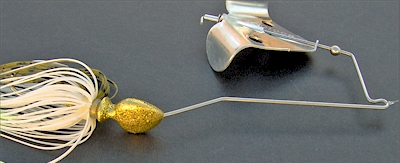
A buzzbait is not a complex lure. There are only a few components. Here are the basics of what to look for:
- A pointy, often flattened jig head, typically on an .045 to mostly .051 wire arm with a round bend hook.
- Look for a pointy nose as buzzbaits are best in cover, and the pointy nose is far more weedless and snagless than other head shapes
- A silicone skirt with forward and backward facing fronds held onto the jig collar by a piece of rubber tubing
- A 2-winged, typically aluminum prop blade on top
- Make sure it has an aluminum rivet bearing against the blade for the infamous squealing noise
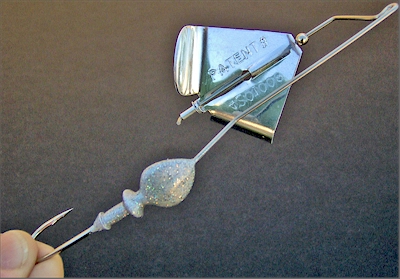
Weights and Sizes. When it tends to be mild weather, I use 1/4 ounce with a medium-sized blade most of the time. I will throw 3/8 ounce especially when the wind makes it tougher to manage. I will use heavier buzzbaits of 1/2 up to 3/4 or 1 oz, but it may often be better to switch to big spinnerbaits if I need to cast farther or cover more water faster. Years ago I threw lots of 1/8 ounce buzzers and caught loads. You can retrieve the 1/8 slower which people claim to be more appealing to fish, and the 1/8 imitates smaller bait of course. Over time though, I usually observed that guys fishing with me who were chunking heavier buzzers usually did just fine for themselves. So I rarely use 1/8 buzzbaits any longer.
It's the Prop, Baby! The main attraction of a buzzbait is that the metal parts squeak when they rub, the blade creates a rhythmic throb. It leaves a bubbly trail and an ever-widening vee wake which makes for easy tracking by bass, even at night. The entire commotion partially obscures the lure skirt from sight, preventing the bass from eyeballing it too closely. With all these things going on up top, the lure skirt itself is less important, and a trailer bait is usually not necessary to attract fish. However, you may use a trailer to adjust the "buoyancy" and/or slow down the speed of the bait.
A Few Surefire Colors. Get comfortable with a white buzz as your mainstay. Here are a few other colors that work:
- Black (or black/red, black/blue): Use absolutely anytime, but particularly at night.
- Fire Tiger: Increases visibility in thick cover, when windy, or for active, aggressive fish in spring and fall
- Clear or Translucent Color Skirts: Use in clear water on sunny days
Not a lot of thought or even much skill needs to go into basic buzzbait fishing. It is not like a jig n' pig where a lot of people claim they can never catch fish on it and the best advice experts give you is to leave all your other lures home..."fish solely with a jig n'pig and go fishless for the next 2-3 years"...until you learn it. Not so with mastering the buzz - just go out on the water and toss it every so often. If bass are in the mood for it, you will generate strikes muy pronto. It's that simple. If you are not getting any action, take it off and try it again later that day or on your next trip.
So here goes. Of course, I've seen many novices who didn't know how to retrieve it correctly, and they would never stand a chance at catching a fish. So here goes.
You must concentrate on your hand-eye coordination. You need to follow the buzzbait flight trajectory by eye during the day or anticipate it as best you can at night. Think baseball - don't cast like the late, great Willie Mays hitting a pop homer over the fences at Candlestick - instead, make a powerful line drive to short center. You need to engage your reel and begin turning the reel handle when the buzz is decelerating and arcing through the last few feet of air before it hits the water. Read that last sentence back to me. Done, properly, your lure should not whiplash back or anything, What should happen is the buzz splashes down, and if you engaged the reel right, the buzz will be gurgling instantly and moving rapidly because the temporary extra tension built up in your line is pulling it towards you a tad. Read it again and no, I did not call you a tad. When that tension is expended, the buzz will relax an instant. EXPECT TO GET BLASTED RIGHT NOW. If there was a fish within 10 feet of this happening, it has come over to check it out. Even better if there were two or more fish in the critical splashdown zone, they are right now racing each other to see who gets to your buzz first. Now, you were turning the reel handle all this time, right? Of course. Just don't stop turning, but you might want to slow down a bit so the buzz gets to a pace you like. At any given time, fish may like it as slow as you can possibly go to barely keep gurgling or they may want it as fast as you can burn it back.
Steer It. If you did not get a hit at splashdown, then you really need to maneuver your rod tip to one side or the other as you reel in. You need to steer the buzz at any cover in its path, floating weeds, rocks, wood. Why? Because you will only get hit again when your lure passes close by these objects. I am not sure why this is so, although I have my opinions. The point is, if I want to get hit, I have to steer my lure to pass within inches of this stuff. Not so sure I always want the lure to "bump" into it, which other people may advise you to do. I can get stuck or glopped up with weeds if I bump it. As a matter of fact, if it looks like the buzz is going to plow right into a log or weeds, then I will start lowering my rod tip and wind the line so it is nice and tight. When the buzz is 6-12 inches away from crashing into the object, then I will reel quickly and control-swing the rod tip up so that the buzz jumps up and over the obstruction without fouling.
Rod High. As for a rod choice, I prefer spinning tackle, believe it or not, so I can wind in buzzbaits steadily with the rod tip pointed way up in the air. I think it gives more life-like action if you always keep your rod tip as high as you can to keep the buzz on top. As a rule, this means 10 o'clock when you have just casted and have lots of line out, and tip up at 11 o'clock by the time you have retrieved most of your line. When it gets within twenty feet of you, you will lose that nice feeling of traction on the surface. There's nothing you can do about this. Just finish out the retrieve as best you can.
You can't easily fish baitcasting rods with the tip held high due to the way you grip the handle, and you won't be able to set the hook easily from that position either. Baitcasters excel with jigs, worms and other deep-running lures where you keep the rod tip pretty much pointed at 9 o'clock or even pointed dead straight down the line angle.
Line to Use. A tight, thin line like a braid or fluorocarbon is a beautiful thing for lures you fish by "feel" such as jigs, Texas or Carolina rigged worms, and slow-rolling spinnerbaits in deep water. But I think a tight line deadens a buzzbait's action. It is hard to describe, but I like a fat, billowy monofilament line with a buzzbait. The line kind of floats and wallows around in the air with buzzbaits. I think it lets the buzzbait exhibit more life-like action. The only time I will go to fluorocarbon with buzzbaits is in very abrasive cover or if there is too much of a wind belly with mono on a blustery day.
Hooksetting. The bass will not let go of the buzzbait for a few seconds or longer - let them take the buzzbait down - do not set the hook when they blow up on the bait - only set after they take it down and you feel solid weight.
Short Strikes. There is a common feeling that bass short strike at buzzbaits. Actually, I don't think they miss it as much as the fact that we react too soon and pull it away before they have a chance to engulf it completely. I do not use trailer hooks if I do not have to. I often fish the buzzbaits near heavy wood and weed cover, and I feel a trailer hook fouls up more than it helps. If I am being plagued by short strikers (it happens), I'd rather trim the silicone skirt first, so the skirt ends barely beyond the hook bend. This way, there is not too much stuff trailing out past the hook for the fish to nip at. If that doesn't solve the short strikes, it's trailer hook time.
Buzzing in weeds can be dealt with, but doing it in wood, like drowned tree tops and logjams, leaves you mentally exhausted by the end of the day because it requires so much concentration and hand/eye coordination to do it successfully. In fact, if I find myself buzzing deep into wood, I need to ask myself, "Why are you doing this - wouldn't you be better off using a jig n' pig?" And I always remind myself that I would then have to fish nothing but the jig n' pig and go fishless for the next 2-3 years until I master it. What I do then is compromise. I take one buzzbait with a stout wire arm and take one jig n' pig with a stout fiberguard. Then I clip off the nose of the buzzbait, form a small loop in the end of the wire arm and attach the fiberguard jig to the buzzbait. Add a trailer to this, such as a twintail grub, and add scent to the twin tails. You can pitch this, buzz it straight at logs, let it bang into or along the length of them, and then fish it like a dropbait. It is much more snagless and versatile than an unmodified buzzbait. Just kill it, let it struggle down to the bottom - jig it around and/or just let it lay there.
When Not to Use It. I find that there are moments, days, weeks, months, and even whole bodies of water when/where the buzzbait just doesn't do it for me. If fish are going to hit the buzz, they'll let you know about it muy pronto. If I give the buzz a chance (and I always do) and the fish don't want it, then I don't use it. It seems pretty clear to me when they don't want it, you can't raise them (at the moment, this day, this week, on this pond, etc.). There's also an in between thing, when they hit, but you can tell their hearts are just not in it. Don't waste your time. The right thing to do here is to go to other lures.
Better Bites on Spinnerbaits or Jigs? There have been times when I think I am doing good with a buzzbait, and somehow I wonder if I might be able to do better with a spinnerbait or other lure like a jig. Sometimes this is true.
Here's how you can find out: Identify a starting place - let's call it "point A" - for a long area that you want to cover, and start buzzing away. Such an exciting lure for the angler to use! There is speculation that it excites the fish too, and can heighten the awareness of less-than-active fish. However, after five casts or so over the same spot, I am always afraid I run the risk of turning the fish negative. Actually, your first cast really matters most. After that, you are fishing used water. So, buzz along a stretch of 100 yards or so. Hopefully, you'll get some bass. Whether you do or not, don't wear out your welcome. Don't cast again if fish violently blow up and miss the bait, or if they make half-hearted attempts at it, or follow it but don't hit. You REALLY risk turning them off, especially the big ones. Just wait until you get to the end of the run, then tie on a spinnerbait and circle back to point A where you started from and refish the same areas with a spinnerbait. Hopefully, you'll pick more fish - maybe even more than hit the buzz. After that, if you are in heavy grass, wood, rocks, return to point A and make a third pass with a fiberguard jig and twintail spider grub or jig n'pig. Pay no mind to the open areas you already covered. Get into the nastiest stuff that you couldn't hit with the 'pinbaits' (buzzbaits and spinnerbaits are sometimes called 'safety pin' or 'pin' baits due to the wires). Go right for the densest weed clumps and shake those weeds up. Cast right at the biggest tree limbs and let the jig BANG full speed, then drop into the water. Knock it around down there. Screw down your drag and throw it 4-5 feet deep into the points and cuts along reed stands. Rustle those canes. Winch a few out of there and you'll get to feeling like you're king again! After you pass down a couple banks like this, first with buzzbaits, then spinnerbaits and jigs - without wearing out your welcome on any one lure - you'll have a good feel for which one bass want to bite best. However, always keep in mind that the 'layered' effect of piquing their interest first with the buzzbait, picking up the active roaming fish after that with the spinnerbait and then going into cover with a jig for the fish that won't come out to chase - that progressive triple-layered approach may be the key - not any one single bait.
Take a Short Break Between Bites. I am always interested to hear if anyone has any good ways to get bass to hit again after they miss a buzzbait. What I like to do is wait 2-3 minutes before casting again to the exact same spot. Especially with big bass, I have found that I risk turning them off completely if I recast to the same spot immediately. I will always remember one dark night when my friend Tony had the biggest commotion completely miss his buzzbait. He was all ready to fire it back out when I advised him, "No, you've got to wait." Well, he lit a cigarette and when he finished smoking it, he put it right back there and caught a nine pound New York bass!
Scent. I do not believe that scent is a major factor to the initial attraction of a buzzbait. Scent may add some value when a fish near misses the bait on the first cast - the taste of scent may encourage the bass to take another swipe when you cast back to the same spot - but we are really belaboring the point here. Some persons say that a buzzbait lays a wake trail (rightfully so) that bass can follow, and they add that wake trail could also lay down a scent trail (if scent's applied), but I don't cotton to that. Also, there's nowhere to put scent on a buzzbait because, if you put it on the blade, the scent tends to promote premature oxidation of the blade. If you put scent on the skirt, it tends to mat the skirt down so it clumps together, and also may deteriorate the skirt or band prematurely. If you do feel a need to add scent to a buzzbait, it may be best to add a soft plastic lure as a trailer, and scent the tail of the worm that sticks out past the skirt edges. This is likely to be the part a fish touches on a short strike, so it's the best place to have scent and the scent will not get on the blade or skirt as much.
Around riprap, always make the lure make contact with the rocks. Sometimes with the buzzbait, I will bring it towards a nice collection of rocks, kill the retrieve and let it helicopter down into thick chunk rock. Then I will just jig it like a jig and let it clank all around down there while I stumble it forward. This is also a good tactic to use in any area, not just riprap, AT NIGHT when bass blow up and miss the buzz. Kill it, let it sink and bumble it around on the bottom…and feel for that mushy kind of jig pick-up.
Deadsticking. Occasionally when I have gotten a wind knot in my line, I have even seen bass pick up the buzzbait after it was resting idle on the bottom for 30 seconds or more. They streak off to the side with it in their mouths - just like they would pick up a rubber worm and streak off with it.
Windy or Calm? Buzzbaits will work in the windiest or calmest conditions and everywhere in between. Early morning and late evening calm waters are "classic" buzzbait conditions. The only thing I will add is that under strong windy conditions over 15 knots, when I think I am doing good in the wind with buzzbaits, I always try spinnerbaits fished a couple of feet under the surface and often find that I can do even better with them.
When and Where?
It's hot, sultry, beautiful buzzbait time once again.
Traditionally, the month of July signals the prime time for buzzbaits because bass will be exploding on them like fireworks on the Fourth of July!
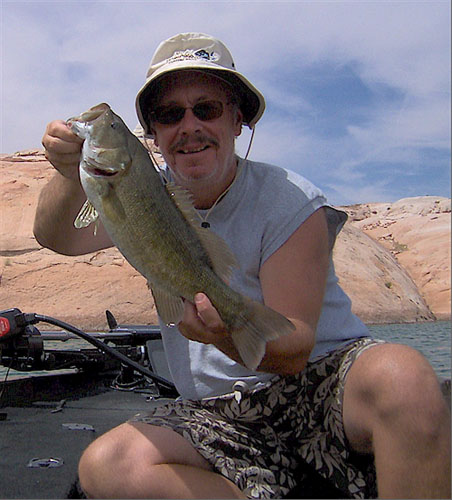
Above, a nice smallmouth that exploded on a buzzbait in less than a foot of water.
Where I fish on Lake Powell (Arizona/Utah) there are a lot of high cliff walls constituting the shoreline. Early morning topwater fishing tends to be best and also lasts longer on what locals call "east-facing" walls. Actually, these are walls on the eastern shores, so technically the walls face west. Still, everyone understands when someone says they had good topwater action running the east-facing walls in the early morning hours. What makes buzzbaiting possible in these locations are shade lines cast under the walls.
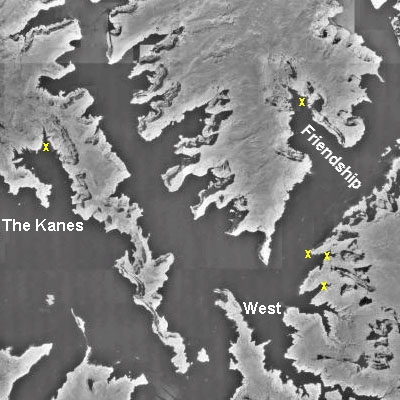
The aerial photo above shows five east-facing walls in spots called the Kanes, a couple of creeks above West Canyon and in Friendship Cove. They fall within a ten mile radius, or ten minutes apart. Running these walls quickly (about 15-20 minutes fishing each wall), you can cherry pick a bunch of decent bass off each wall while they are still throwing down some shade. This same "run and buzz" pattern can produce anywhere that east-facing shorelines throw down early morning shade a little longer time than more open shorelines.
A key aspect however, is not just any east-facing walls, but the real key is for otherwise good spots to lie underneath the east-facing walls. Simply because there is an east-facing wall, that does not make it a good spot. What sweetens four of the five spots shown on the aerial photo is that each is an inflowing creek mouth. The fact they lay under east-facing walls makes them prime for early morning buzzbait or topwater action. Another plus is these spots are clustered less than a ten minute boat ride apart from each other. So you can run them all quickly and pull a few decent bass off each wall if you are lucky.
Buzzbaits at Night
Compared to daytime fishing, everything's slower (in terms of lure action) at night, and surface swimmers, topwater crankbaits or buzzbaits that may be slowed way, way down are a good choice, often the darker the color the better. The key to many topwater lures (and this applies to all lure types in general) at night is that lures which leave a slow, steady, turbulent trail seem best. On the other hand, splashy, jerky topwater lures such as poppers or stick baits that "walk the dog" usually won't fare as well at night. Lures that rely on lots of flash, speed, or erratic stop-and-go action tend to work better by day than at night. Lures like a slow, plopping buzzbait or steady surface swimmer are the best topwater choices at night, Who knows why? It's just the way things go after dark.
Two Rods Better Than One
I often rig two buzzbait rods:
- one baitcaster with a heavier buzzbait and heavier line, and
- one spinning rod with a lighter buzzbait and ten pound test.
This way I can change buzzbait styles, actions, sizes, also change casting arms, and if one rod temporarily goes "down" or out of commission due to a line snarl or for whatever reason, I can instantly pick up the other rod to keep fishing.
Make no mistake, you WILL catch more bass using two different rods, two different buzzbait presentations (one casting, one spinning). You will catch less fish using only one rod.
If you are lucky enough to fish somewhere that is a trophy bass fishery, then beef up the power of the spinning rod to whatever strength spinning gear is necessary. The fact that you hold a spinning rod differently, reel it in differently, with a different buzzbait is part of the ability to show bass two different presentations, resulting in more strikes and greater success.
Add a Third Rod for Throwbacks Also
A third rod with a throwback soft bait (either weightless or lightly-weighted) is also essential to throw back at any good fish that blow up but miss the buzzbait, follow it to the boat or that you otherwise spot with your eyes or on the sonar. They may or may not swipe at the buzzbait again (or at all) but you can often catch them on the throwback soft bait of your choice. It's tough to beat a 4 or 5 inch Senko as a throwback bait.
Indeed you may catch more fish some days on the throwback bait than on the primary buzzbaits themselves! It's all good!
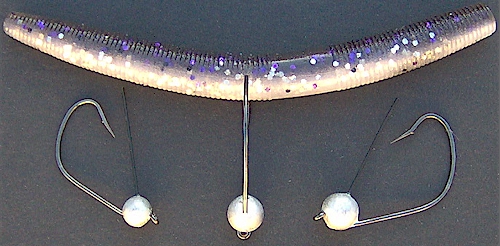
A good throwback bait rigged and ready to throw - is essential. Shown above is a 4-inch 9S-Series Yamamoto Senko in "threadfin shad" color #927 with lightweight 1/8 and 3/16 oz Bassdozer Wacky Jigs. Being able to instantly throw back an unweighted or lightweight soft bait can be crucial to catching many more bass than just with buzzbaits alone.
Although this info is specific to how I use buzzbaits on Lake Powell, you will be able to apply some of these principles to your own home waters anywhere. Good luck!
The Fine Art of Tuning Buzzbaits
Most buzzbaits have only one blade with two paddles on the single blade. That is the "classic: buzzbait" configuration.

With only one blade turning, it creates torque to only one side. So the buzzbait would prefer to roll over on one side due to that torque, and it will not come in straight. Instead, a single blade buzzbait tracks. to one side or the other (depending whether the blade spins clockwise (most do) or counterclockwise.
Most of the time, you want to try to adjust what it is about the buzzbait that is making it lay over on its side. You start by looking to see that every little aspect of the buzzbait is lined up perfectly straight - the 'nose arm', the 'blade arm' you look at the jig head to see if it and the hook are straight. It is normal for all these things to not be 100% straight sometimes even out of the box - and especially not after its knocked around in your tackle box or by a few fish. Once you feel everything is straightened out (without excessive bending which weakens the wire), then test cast it, and see if it does not roll on its side now. If it does roll on its side, you have to bend in the 'opposite' direction of the side roll - which is not always intuitive which way is opposite to the side roll. If the buzzbait is rolling to the left side, bend to the right to counter that roll, and then test swim again. If it got worse rather than better, then bend to the 'other right'! Exactly what to bend - the blade arm, the nose arm, the jig head, is really a case-by-case basis. If there's one part that was misaligned or "out of odds" from the others, it's probably the culprit. Don't bend more than you have to - or you are fatiguing the wire. Sometimes you don't need to bend left or right, but need to bend the blade arm closer (or further) from the nose arm, change the degree of the "oxbow bend" and other odd tweaks to get it not to side roll "as much" (the operative phrase here is "as much" because a buzzbait with only one blade will always want to side roll to some degree - and especially at faster retrieve speeds.
You may have heard that not every crankbait is the same. You may have twelve identical crankbaits, even some of the best made brands, and three of them will catch most of your fish, 3 may never catch too many, and the other 6 will only ever be average. There's no way you can see what makes the 12 identical cranks good, bad or fair - but fish can sense it. Many anglers do not realize the same phenomena exists with buzzbaits or with any other lure type. You can have 12 buzzbaits, and 3 are winners out of that dozen. Who knows why? Some people say it is squeal, but I do not think that squeal's such a big factor as its always made out to be. A "good" buzzbait squeals more simply because it's used more and therefore the parts are worn more. But in terms of squeal being a factor that makes one buzzbait more preferable to bass - squeal's a myth. You'll never know what makes 1 crank or 1 buzz work better, but you do need to understand the phenomena exists. Look for it - and make the most out of the situation. Usually, it will be the crankbait or buzzbait that swims perfect out of the box, that's a good indication it is going to catch a higher percentage of fish. A lure you have to work on right out of the box in order to tune it, that's an indication it's not going to be one of your greatest.
As far as the buzzbait retrieval path leading to the side (left usually) instead of straight in - you can never really correct that with a single blade buzzbait - so just plan for that to happen. Plan to cover that sideways path back in when you cast.
There are some buzzbaits (see photo below) that have multiples blades - one blade that spins clockwise and a second blade that spins counterclockwise, and they negate each others torque, so will not sideroll and will not come in to the side - but tend to act straight (as long as they're not bent out of whack). Each blade turns in the opposite direction to provide a straight track. However, these are not so common.
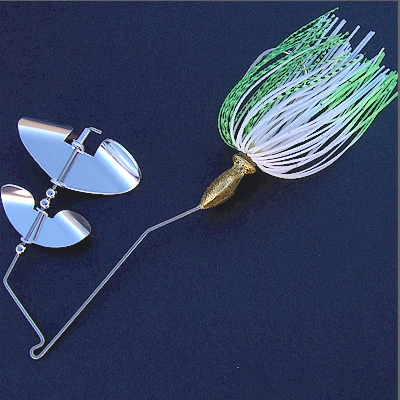
Spinner Buzzbaits
A trailing spinner blade on a swivel adds a second churning, bubbling wake behind the primary buzz blade. The spinner blade jumps and bumps and gurgles and bounces. It adds flash, movement, noise, traction, spit, splash, turmoil... more of all the things we tend to feel make a buzzbait great. And if you face moments when you don't want all that, you can remove the swivel and spinner blade in a few seconds, and it reattaches just as easily. I can tell you, however, I have never felt the need to ever remove the spinner blade and swivel, but you can if you want to do that, and you'll still have a standard buzzbait.
An important thing which this add-on addresses is that awkward moment when your buzzbait first splashes down and for whatever reason, you don't get it to instantly start churning on the surface. This is an important point with buzzbait fishing as many strikes happen within those first few seconds. There are many claims of buzzbait heads designed to plane and rise to the surface instantly. I experimented with those claims in my test pool the other day. I took one each of all the popular brands of buzzbaits that claim to instantly plane to the surface. I threw each one by one into the pool and you know what? They all sank. Not a single one lived up to their illustrious marketing claims. Not one of those buzzbaits has planed to the surface yet. This test proves that how quickly a buzzbait planes to the surface upon initial splashdown is NOT a function or feature of the jig head. It is mainly a function of the angler using his rod position, line angle and reel to make a buzzbait plane as soon as possible. It's often unavoidable that the buzzbait will initially submerge, if only for a few seconds before the angler's actions raise it to the surface. During those first moments when the buzzbait is submerged under water, I tend to get more hits with the spinner blade. I attribute those bonus strikes to the trailing spinner blade doing it's thing to attract bass. There are some days I get more strikes in the first few seconds when the buzzbait is under the water than I get for the entire rest of the retrieve, and I attribute that to the spinner blade doing its thing underwater somewhat similar to a spinnerbait blade.
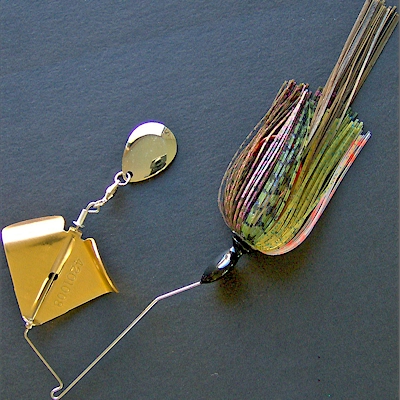
Bassdozer Pro Buzzbait ~ 3/8 oz Bluegill Spinner
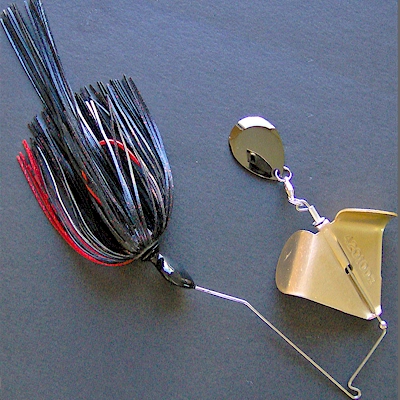
Bassdozer Pro Buzzbait ~ 3/8 oz Black Red Spinner

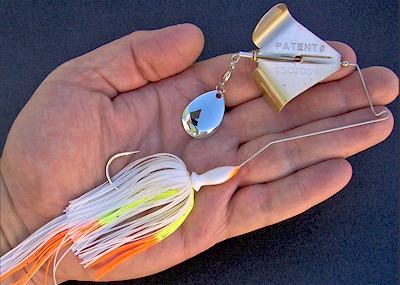
Bassdozer Pro Buzzbait ~ 3/8 oz Smallie Special Spinner
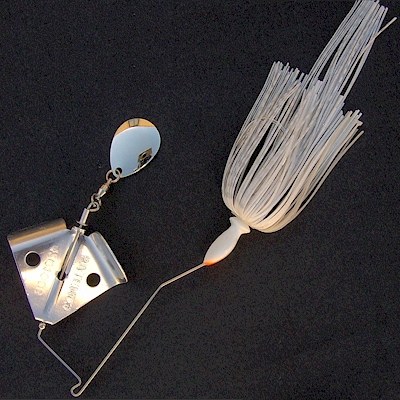
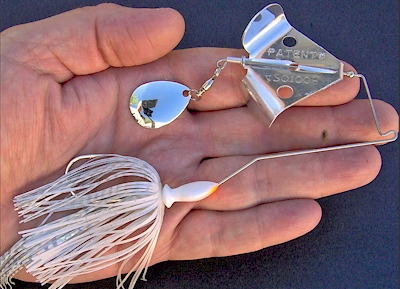
Bassdozer Pro Buzzbait ~ 3/8 oz White Shad Spinner
Other Buzzbait Blade Styles
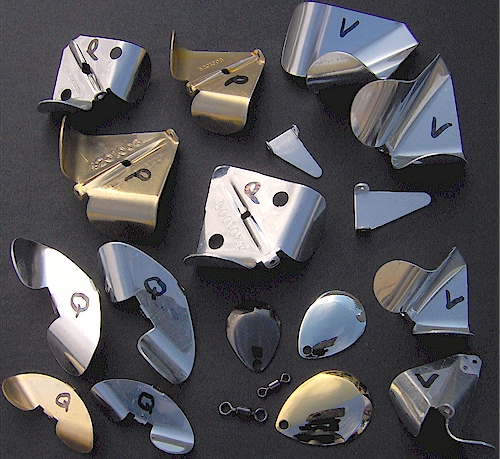
Buzzbait Blade Styles. The smaller style P, Q and V blades, the small clacker and small Colorado spinner match up best with 1/4 oz buzzbaits. The bigger P, V and Q sizes work swell on 3/8 and 1/2 oz models. These no reason for the letters used (P, Q, V) except they're just a short, easy way to identify different styles.
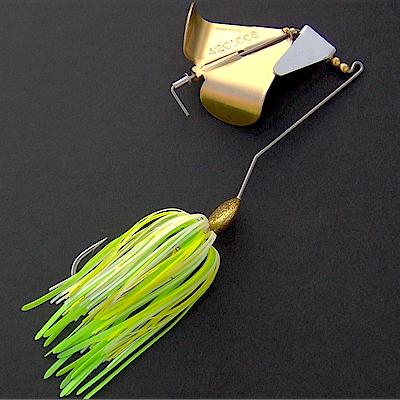
3/8 oz Citrus Shad ~ Clacker. Bottom beads ensure the clacker sits up high enough so it constantly contacts the main blade. The longer wire bent down behind the rivet effectively shortens the blade arm and ensures the main blade stays far forward and in constant contact with the clacker too.
Give Fish a Choice. Let Them Decide. I often alternate casting with two or more different buzzbait rods when I am fishing buzzbaits, and between the various different P, Q and V blade set-ups, fish will hit them all about equally most of the time. The different blade set-ups do behave, look and sound different, but are not so different that fish won't hit most of them sooner or later on most days. Part of the reason is a lot of time, testing and experience have gone into optimizing every different blade set-up, so by the time you see them in Bassdozer's Store, they are all about as good as a buzzbait can get, and all have what is needed to best attract strikes.
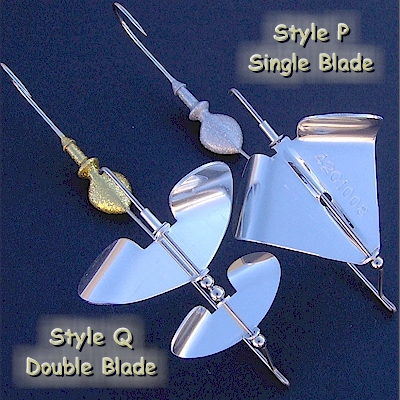
Style Q Buzzbaits
Style Q Blades. I call this double blade configuration the "Style Q". There's no meaning for it, except to distinguish the Style Q double blade version from the Style P single blade buzzbait. The Style P (shown on right in photo) is the standard style buzzbait. Style Q (on left in photo) is a configuration I came up with in order to show fish something different. When you throw a buzzbait for two years straight, it can get recognizable to fish. So Style Q is something a bit different, and it's action is a bit different.
I have experimented with many different possible double blade configurations. The bane of most every double blade buzzbait is that they do not cast well. Even the industry-standard Style P single blade is not a great casting lure. To the contrary, the Style Q configuration casts like a rocket. It rifles out there. Upon splashdown, the Style Q rises to the surface as quick or quicker than a standard single blade buzzbait. The Style Q can be fished on top as slow or slower than a standard single blade buzzbait, and it squeaks and squeals as much or more. The Style Q performs the typical churning, bubbling retrieve. In addition, there are two different action that can be made with the Style Q:
- Plopping. This is just letting the counter-rotating blades (one blade turns clockwise, the other blade turns counter-clockwise) plop and plink on the surface. This is a natural action like a shad blipping on the surface or a small fish feeding on tiny insects. It is not a frantic gurgling, splashing action (although the Style Q can do that too).
- Waking. This simply leaves a wake like an individual fish (or a tight school of bait) leaving a vee wake. It is not "bulging" the surface, like can be done with a spinnerbait, that leaves a bulge behind. This tactic with the Style Q leaves a vee wake like one adult shad (or baitfish) pushing water with its nose, or a school of tiny baitfish muddling along on top, leaving a vee wake.
The blades turn in opposite direction on the Style Q, making it run relatively true. The blades do not torque the hook and skirt over on one side like a standard single blade buzzbait tends to roll up on one side. So if you want to speed up the retrieve, the Style Q is more stable at faster speeds than a standard single blade buzzbait.
The Style Q... it's an oldie but a goodie for me, and now available for you to try.
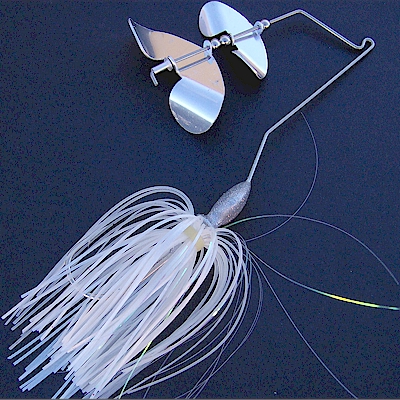
3/8 oz Style Q ~ White Pearl Flash

3/8 oz Style Q ~ Alewife
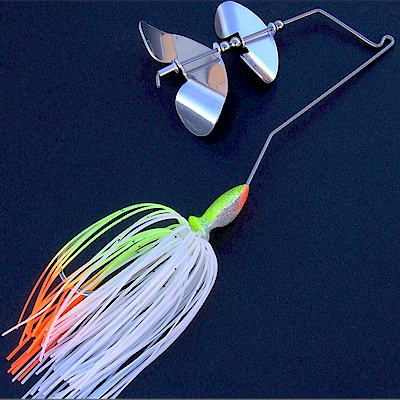
3/8 oz Style Q ~ Smallie Special
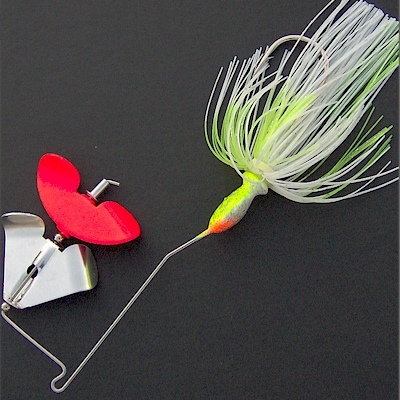
1/4 oz Style Q ~ Chartreuse White Blend. In keeping with its smaller 1/4 oz size, this buzzbait sports a 'thin cut thin strand' skirt that's 4" long (not the standard 5" skirt). Double downsized yet active blades work perfect on the high-vibe .040 wire arm. Front blade is unpainted aluminum. Back blade is painted fluorescent red.
Style V Buzzbaits
Quad Style V Blades. The next buzzbaits have a two-piece four-wing blade Style V blade. The two blades knock against each other. The sound is remindful of an old time steam-powered locomotive clacking over some rickety railroad tracks, and it has more squeal, splash and splutter than a single two-wing blade. Most important, with four blades, it can be retrieved far slower than a standard buzzbait.
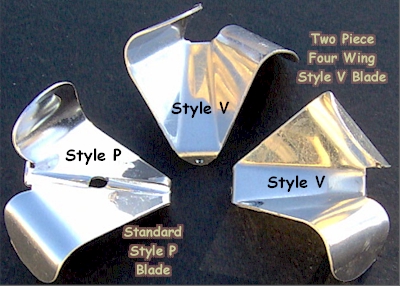
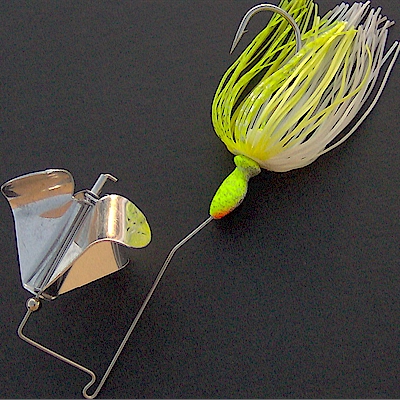
1/4 oz Style V ~ Chartreuse White Hologram
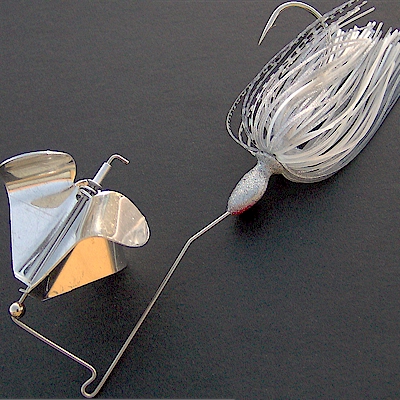
1/4 oz Style V ~ Shad-A-Delic
Style V Blades. These are used in pairs. It's actually two identical parts (with two blade cups apiece) that interlock to make a four-bladed buzzbait. The two parts constantly bash each other adding a metallic chugging dimension to the squeaks and squealing sounds emitted by this contraption. With four blades, the Style V slowly churns the surface in a small frenzy of sprayed white water.
More Multi-Blade Buzzbaits
These buzzbaits possess premium components and features:
- Set-back, long shank, oversized Gamakatsu hook
- Dropped-down, oxbow wire bend for more solid strikes
- Strong .051 diameter wire for great strength in 1/2 oz model
- Strong .040 Super Wire enhances vibration in 1/4 oz model
- Streamlined fast-planing head snakes through cover with great deflection
It's not any one feature but the 'total package' and attention to detail that makes these buzzbaits great.
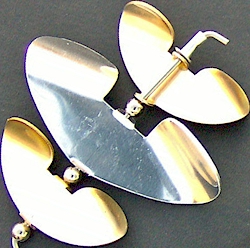
Triple Counter-Rotating Blades. The smaller front and back blades rotate one way. The bigger center blade turns in the opposite direction. So you have both clockwise and counterclockwise blade action. The combined counter-effect negates torque or tendency for the buzzbait to lean or come in to the side. It comes in perfectly straight as an arrow, and that is especially helpful for an angler who needs to plan how to snake it through thick grass. The straight line path makes it easy to manipulate. It casts like an arrow too - straight, far and true. The triple blades present a lot of motion flailing on the surface every which way. The noise it produces has a shaking, rattling element that you don't get with other buzzbaits.
Front and back blades are lacquered amber finish resulting in a gold effect. Center blade is unpainted aluminum
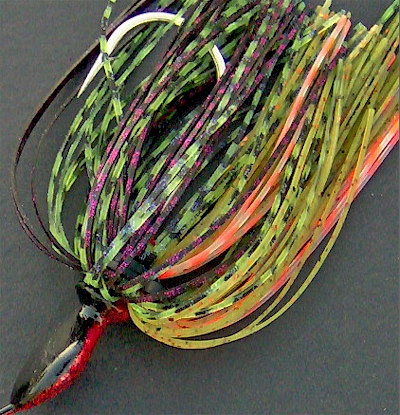
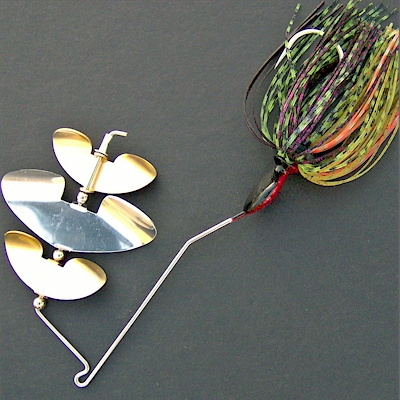
1/2 oz Style Q ~ Bluegill.
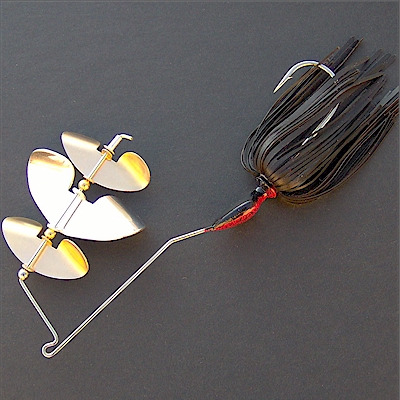
1/2 oz Style Q ~ Black
Super Heavy Duty Buzzbaits for Big Bass
These are the ones you want for the biggest bass in the baddest cover.
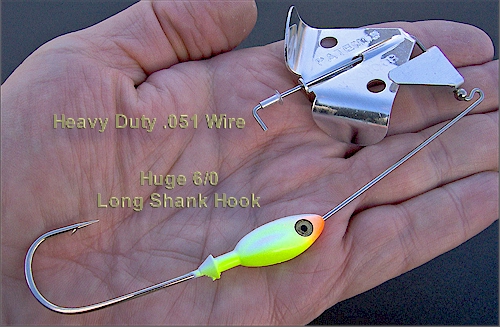
Huge 6/0 Long Shank Hook. This Mustad Ultra Point is the biggest, longest, strongest stock spinnerbait hook on the market. It's positively what you need for the biggest bass out there.
Style C Head. The Style C head is streamlined to snake right through brush and grass about as weedless as a bullet-shaped Texas rig sinker. It's the same tapered, conical nose shape, and shares the same weedless and snagless advantage as a bullet sinker.
The Style C head is very stable and does not roll over or on its side because it has a "belly bulge" of weight that acts as ballast to keep it from rolling over. This is an advantage over other typically wide, flattened, planing type buzzbaits heads. The wide, flattened types tend to roll over, retrieve to the side instead of straight, collect weeds on the wide head and wedge into brush. The Style C holds its course fairly straight and resists rolling up on its side during the retrieve. Due to it's bullet nose, it doesn't collect weeds or wedge into brush as much.
The compact frame keeps the buzzbait body up closer to the surface. There is a short distance between the nose arm and the blade arm. So it rides up higher over subsurface weeds and limbs.
The long, huge hook is set back so far to make the addition of a trailer hook unnecessary most of the time. This is a plus because having to add a second trailer hook raises the odds you'll get snagged or drag weeds along on the hook, ruining your presentation.
How to Hook a High Percentage of Strikes (without a trailer hook). As with all topwater baits, there is a knack to setting the hook. When a fish boils up on any topwater or buzzbait, you have to "sleep on them" meaning not set the hook at all. Just keep reeling steadily as if nothing's going on. Meanwhile, a big bass may be doing cartwheels all over your buzzbait. All gamefish, not only bass, miss topwater presentations a good percentage of the time. If you just keep reeling like nothing's happened, most fish will strike again until they grab the buzzbait (or whatever topwater lure) securely, then they'll go down with it. When you feel the solid weight of the fish moving downward, let the fish pull the line tight. All the while, you are reeling steadily. Chances are, the fish is not going to let go of its prize, but don't wait too long. Keep in mind, this all happens in an instant. Then set the hook with a solid sweep. Between you pulling on the rod and the fish gripping down on the bait against the resistance it feels, you can hook a fish almost every time like this. If you master this technique, you will hook most every fish that strikes a properly-designed buzzbait like the one here. Trust me, it can be done! Practice makes perfect. If you do not master this technique, you will miss many strikes and you may find you often have to use a second trailer hook.
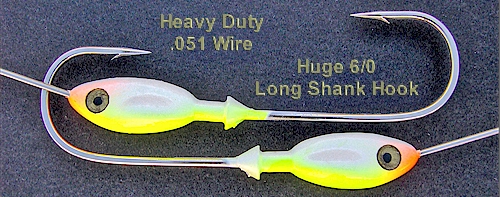
The style C buzzbait has a super heavy duty .051 Super Wire arm.
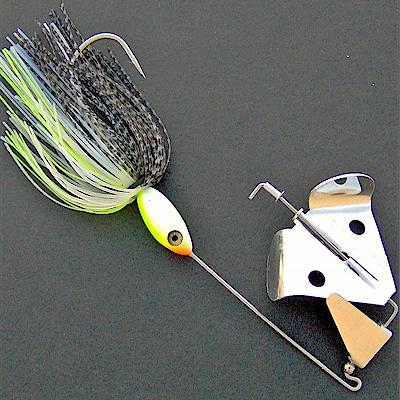
1/2 oz Style C ~ Sexy Shad
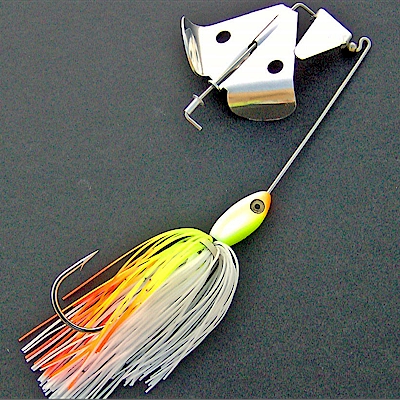
1/2 oz Style C ~ Smallie Special
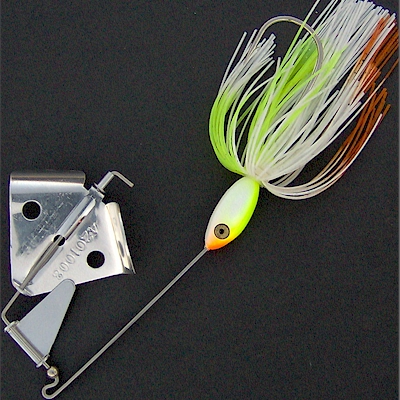
1/2 oz Style C ~ Chartreuse White Bone
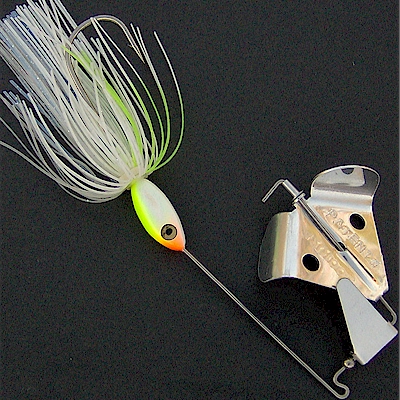
1/2 oz Buzzbait ~ Style C ~ Pearl Blue Chartreuse
Fantastic Five Blade Buzzbait
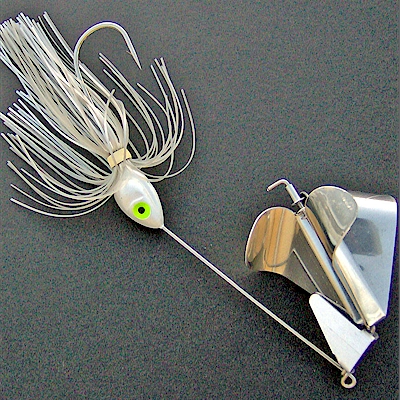
3/4 oz Style B ~ White Shad
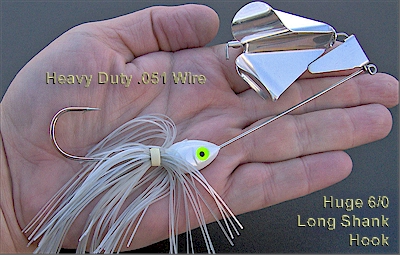
Five Blade Buzzbait. This is a huge buzzbait with a total of five blades. Wire arm is .051 diameter. The 6/0 Mustad Ultra Point hook is huge. It's one of (if not "the") biggest stock spinnerbait hooks on the planet. The Style B head shape is very stable and does not roll up on it's side during the retrieve.
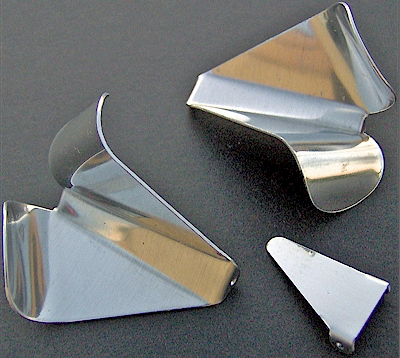
The two blades fit together and hammer against each other in addition to the clacker blade that ticks off the other four blades. Overall effect sounds like an old time train clacking down rickety old railroad tracks.
Fast or Slow? Let the Bass Decide. This buzzbait blade configuration can be retrieved fast and fish will explode on it that way. It can also be slowed way, way down (with the rod tip held high) and it will almost gurgle or cluck slowly at slower speeds. Its versatility is an asset of this blade set-up.
Some days they want the buzzbait slow, the next day fast. It's a trial-and-error method to begin each day to discover what the fish want from you, and once you get results with a certain cadence, refine it, lock yourself into it and stick with it the rest of the day (or for however long as the buzzbait bite lasts).
For pricing and current availability, please visit http://www.BassdozerStore.com.
Thank you for your business. May your next fishing trip be your best ever!
Regards,
Russ
